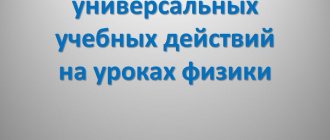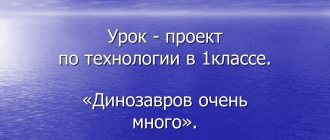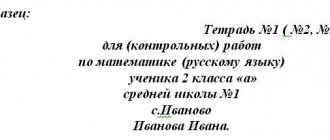Array assignment
1.
The teacher can assign any level of homework as an array
.
For example, a teacher gives ten problems (or, say, poems), from which the student must choose and solve (learn) at least the pre-agreed minimum amount of the task.
Delayed reaction
After asking a question, the teacher is in no hurry to question the students. There is a certain pause . This allows those smart kids who, due to their personal qualities, are slower to react to a changed educational situation to “catch up.” In elementary school, a student is often in a hurry to express his own self : he reaches his hand up, sometimes without even having a ready answer to the question posed by the teacher. At the same time, a phlegmatic student (outwardly slow-witted), upon reflection, can give us a brilliant answer.
Pedagogical techniques for the formation of UUD article on the topic
Pedagogical techniques for the formation of UUD
Panenko Irina Nikolaevna
For elementary school in modern conditions, the priority is the formation of educational activities, such as the desire and ability to learn, the development of cognitive interests, and a responsible attitude towards one’s activities and its results. Achieving this goal becomes possible thanks to the formation of a system of universal educational activities. I would like to dwell on those techniques that help the formation of UUD.
UUD, their properties and qualities determine the effectiveness of the educational process, in particular, the acquisition of knowledge, the formation of skills, the image of the world and the main types of competence of students, including social and personal.
Today, when preparing for a lesson, a teacher must ask himself the question: “What can I do to increase interest in the educational material so that the student wants to learn? So that he clearly understands, while working on educational material, why he needs it.”
Personal actions make learning meaningful, ensure the significance of solving educational problems, linking them with real life goals and situations, they are aimed at awareness, research and acceptance of life values and meanings, allow you to navigate moral norms, rules, assessments, and develop your life position in in relation to the world, the people around you, yourself and your future.
Regulatory actions provide the ability to manage cognitive and educational activities through setting goals, planning, monitoring, correcting one’s actions and assessing the success of learning. A consistent transition to self-government and self-regulation in educational activities provides the basis for future professional education and self-improvement.
Cognitive actions include the actions of research, search, selection and structuring of necessary information, modeling of the content being studied, logical actions and operations, methods of solving problems.
Communicative actions provide opportunities for cooperation: the ability to hear, listen and understand a partner, plan and coordinately carry out joint activities, distribute roles, mutually control each other’s actions, be able to negotiate, conduct a discussion, correctly express one’s thoughts, provide support to each other, effectively cooperate with both teacher and with peers.
Dear Colleagues! Listening to my speech, I suggest you work on the Fishbone technique. The word fishbone literally translates as “fish bone.” This strategy allows students to break down a general problem into a series of arguments and reasons. The visual image is similar to a fish bone. If placed vertically, then on a Christmas tree. Students who master this strategy are dominated by meta-subject competencies such as critical thinking, interaction in groups, planning and carrying out research activities. The creator of fishbone is Japanese professor Kauro Ishikawa.
In the head of the fish, write the word “pedagogical techniques”, at the end write what they are needed for. On the sides are the techniques that you liked.
Personal UUD
- Array tasks –
1. The teacher can assign any level of homework in an array. For example, a teacher gives ten problems (or, say, poems), from which the student must choose and solve (learn) at least the pre-agreed minimum amount of the task. 2. A large array of tasks is assigned at once - within the framework of a large topic being studied or repeated. For example, out of 60 problems, a student must solve at least 15, the rest are optional. And to stimulate this desire with relay control work, composed of tasks from this array. The more you solve, the greater the likelihood of encountering a familiar problem and saving time and effort. Such an array is not set for the next lesson, but for a longer period of time.
An important psychological effect: independent choice of task provides an additional opportunity for self-realization, because it is known how students in our school lack this, especially in adolescence. And the academic subject, in turn, becomes more interesting to them.
- Going beyond
In the course of constructing a lesson, the teacher goes beyond the boundaries of the textbook, the subject, harmoniously weaving into the fabric of the lesson the latest events, examples from the surrounding reality, scenes from popular cartoons (for example, when studying the topic “Healthy lifestyle”, one of the episodes of the cartoon “Smeshariki” is discussed) or children's series.
- Delayed reaction
After asking a question, the teacher is in no hurry to question the students. There is a certain pause. This allows those smart kids who, due to their personal qualities, are slower to react to a changed educational situation to “catch up.” In elementary school, a student is often in a hurry to express his own self: he reaches his hand up, sometimes without even having a ready answer to the question posed by the teacher. At the same time, a phlegmatic student (outwardly slow-witted), after reflecting, can give us a brilliant answer
- Catch the mistake
1. When explaining the material, the teacher intentionally makes mistakes.
First, students are warned about this in advance. Sometimes, especially in the lower grades, they can even be told “dangerous places” by intonation or gesture. It is important to teach children to react quickly to mistakes.
- 2. The student receives a text with deliberate errors - let him “work as a teacher.” Texts can be prepared in advance by other students, including older ones
Theatrical performance: Acting out skits on an educational topic, staging
excerpts from fairy tales, short stories, dubbing of fairy tale characters and heroes
cartoons
- Ideal task: The teacher asks students to do a homework assignment of their choice.
- Business game “I am a teacher”:
The use of a lesson form such as a business game can be considered as the development of a role-playing approach. In a business game, each student has a very specific role. Preparing and organizing a business game requires comprehensive and thorough preparation, which in turn guarantees the success of such a lesson among students. Playing is always more interesting for everyone than learning. After all, while playing with pleasure, as a rule, you do not notice the learning process.
Regulatory UUD
- Protection sheet:
Before each lesson, always in the same place, there is a “Protection Sheet”, where each student can enter his last name without explanation and be sure that he will not be asked today. But the teacher, by filing these sheets, keeps the situation under control.
- Discussing homework:
The teacher, together with the students, discusses the question: what should the homework be like so that the new material is well reinforced? At the same time, naturally, the studied material is reviewed again. When used regularly, it significantly increases the awareness of doing homework. This technique works especially well when the methods and types of homework that the teacher usually gives are quite varied.
- Login to the lesson:
The teacher begins the lesson with “setting up”. For example, let's introduce a lesson plan. This is best done in a half-joking manner. For example: first, we will admire the deep knowledge together - and for this we will conduct a small oral survey. Then we’ll try to answer the question: (lesson topic in question form). Then we’ll train our brains to solve problems. And finally, let’s pull out the most valuable things from the recesses of memory (repetition theme). If technically possible, the lesson can begin with a short musical phrase. It can be major-exciting, like Khachaturian’s “Sabre Dance” or Ravel’s “Bolero”. Or minor-calming, like Sviridov’s romance... From the traditional analysis of homework. For an intellectual warm-up - two or three not too difficult questions to think about. From a traditional oral or short written survey. A simple survey - because its main goal is to get the child ready for work, and not to stress him out with a headache... There may be other options for “entering” the lesson
- Question to the text:
When studying a scientific text, students are given the task of making a list of reproductive, expanding, and developmental questions for it. Then they are divided into groups: -questions that can be answered in class; — questions to which no one may yet know the answer. It is proposed to write questions about the text being studied in a certain amount of time: why, how to prove, how to explain, in what case, how, etc.
- Repeat with control:
The student develops checklists for all previously studied topics. A competition list is possible, you can conduct a test survey on one of them
Get to know the criteria: the teacher introduces students to
criteria by which marks are given for different types of work.
- Work in groups: groups can receive either the same or different tasks, but working towards a common result of the task.
- "Jockey and Horse":
The group is divided into two parts: “jockeys” and “horses”. The first ones receive cards with questions, the second ones - with the correct answers. Each “jockey” must find his own “horse”. This toy can be used even in lessons of learning new material. Its most unpleasant feature is the need for the entire group of students to walk around the classroom at the same time; this requires a certain culture of behavior.
- Work in pairs:
Work in pairs can be organized both when studying new material, and when repeating, consolidating, monitoring knowledge, i.e. at any stage, in any type of lesson. The first thing you need to teach students is to check each other. You can check the answer, the progress of the solution, the correctness and beauty of the letter, homework, etc.
- Traffic light:
In many ways, the problem of increasing the effectiveness of oral questioning is solved by a technique that we will call: “Traffic light”. A “traffic light” is just a long strip of cardboard, red on one side and green on the other. FORMULA: when questioning, students raise the “traffic light” with the red or green side towards the teacher, signaling their readiness to answer. The way the traffic light is used depends on the type of survey. A red signal means “I don’t know!” This is an alarm. It’s as if the student gives himself a bad grade, even if it doesn’t go into the journal. Green signal - “I know!”
Faces: Students signal their emotional state by using cards with pictures that represent a good, calm, or bad mood.
- Self-monitoring and self-assessment sheets:
Self-control sheet. After completing the work independently, the child takes a self-control sheet (with answers) from the teacher and checks himself. The self-assessment sheet is necessary for teaching schoolchildren to self-assess their achievements, reflect and predict the results of their work. During the school year, it is important to use achievement assessment sheets during the goal-setting and reflection stages. You can include work with an achievement assessment sheet during each lesson, then students have the opportunity to comprehend and understand the final result of learning for a certain period.
Rating (from the English right - correctly): after completing the work, the student gives himself a mark. She is then assessed by the teacher. A fraction is written. For example: 4/5, where 4 is the student’s mark, 5 is the teacher’s mark. The technique is used to agree on marking criteria. After some time, the numerator and denominator increasingly coincide. Another goal of using this technique is to develop the ability to regularly evaluate your work.
.
- Good bad:
A technique aimed at activating the mental activity of students in the lesson, forming an idea of how the contradiction works.
Forms:
- the ability to find positive and negative sides in any object or situation;
- the ability to resolve contradictions (remove the “cons” while maintaining the “pros”);
- the ability to evaluate an object or situation from different positions, taking into account different roles.
Cognitive UUD
- Let yourself be helped:
- The teacher makes the most of situations in which students can help him. He invites students (on a voluntary basis!) to develop material that can be used for further use in class (this could be assignments for a test, a crossword puzzle for repetition).
- Brainstorm:
a widely used way of generating new ideas to solve practical problems. Its goal is to organize collective, mental activity to find non-traditional ways to solve problems. Using brainstorming in the educational process allows you to solve the following problems:
- Creative assimilation of educational material by schoolchildren;
- Connection of theoretical knowledge with practice;
- Activation of educational and cognitive activity of students;
- Forming the ability to concentrate attention and mental efforts on solving a current problem;
- Formation of experience of collective, mental activity.
- Your examples:
Students prepare their examples for new material, write their own problems, put forward their ideas for using the studied material.
- "Yes and no":
The game puts students in an active position. This game “teaches”:
- connect disparate facts into a single picture;
- systematize existing information;
- listen and hear students.
The essence of the game: the teacher wishes for a number, an object, a literary or historical character, etc. Students must find out what the teacher has wished for. To do this, they ask questions to which the teacher answers only with the words “yes”, “no”, “and yes”, “and no”.
- Chain survey (magic wand):
The magic wand is passed around the class in a random order, accompanied by a speech according to a predetermined rule. For example, the transmitter calls any number, and the other one calls 2 more, etc. In Russian noun + adj = verb.
- Training test:
The teacher conducts a traditional test, but marks are given only at the request of the students. The use of reference books, dictionaries, etc. is permitted.
- Blitzcontrol:
Control is carried out at a high pace to determine the degree of mastery of simple learning skills. The test is checked immediately, by reading or posting the correct answers. My invention: I include in the blitz test the main topics studied that day in subjects. For example, the Russian language: subject, predicate, mathematics, subtraction in a column, the world around us: parts of the river.
- Fantastic supplement
The teacher complements the real situation with fiction. You can transfer the learning situation to a fantasy planet; change the value of any parameter, invent a fantastic plant and animal, transport a real or literary character in time; consider the situation being studied from an unusual point of view, for example through the eyes of an alien.
- Surprise:
A technique aimed at activating mental activity and attracting interest in the topic of the lesson. Forms: the ability to analyze; the ability to identify and formulate contradictions. The teacher finds a point of view in which even well-known facts become a mystery. It is well known that nothing attracts attention and stimulates work like something surprising. You can always find a point of view in which even the mundane becomes surprising. These may be facts from the biography of writers.
- Your support (cheat sheet):
A form of educational work, during the preparation of which the skills of “collapse and expand information” are developed under certain restrictive conditions. A student can answer using a “cheat sheet” prepared at home if: 1) the “cheat sheet” is drawn up on an A4 sheet of paper; 2) there is no text in the cheat sheet, and the information is presented in individual words, symbols, schematic drawings, arrows, and the location of information units relative to each other;
3) the number of words and other units of information corresponds to the accepted conditions (for example, a sheet can contain no more than 10 words, three symbols, seven arrows or lines). The best “cheat sheets” are displayed on the stand as they are used in the lesson. At the end of the topic, the results are summed up and the winners are awarded.
- Fishbone:
In the lesson I use fishbone in a simplified form. For example, in a Russian language lesson, when studying the topic of the name adjective: I put a new part of speech in the head of the fish, then on the sides what the children learned about this part of speech and the conclusion that this name is an adjective.
- Working with Internet resources:
For students, working with Internet resources means access to a huge amount of necessary illustrative and informational material, which is sorely lacking in libraries. This is, first of all, an impetus for self-education and activation of students’ cognitive activity, as well as a choice that children do not have when working only with a textbook.
Communicative UUD
- Interrogation
- Peer review
- Organization of work in groups
- "Yes and no"
- Consult:
The teacher consults with students, discussing, for example, relationship problems. He convinces students that their opinion is important to him, but warns: the last word remains with the teacher. It is important to thank students for sharing the discussion.
- Mini-project and mini-research:
The educational project as a complex and multi-purpose method has a large number of types and varieties. Methods of modern science are used: laboratory experiment, modeling, sociological survey.
Mini research: the teacher encourages children to choose the right research topic. We ask you to answer the following questions. For example, in the poem I offended my mother, there is a phrase I will look for ore, Question: where in our country is the most ore mined?
- Topic intersection:
Students select or come up with examples, tasks and ideas, questions that connect the last studied material with any previously studied topic. (This technique allows you to look at your buildings from your own angle each time. For example, in a reading text, find words with an unstressed vowel.
Thus, the inclusion of non-standard situations in the lesson, the use of new pedagogical techniques, the construction of a lesson in the technology of an activity-based teaching approach, contributes to the formation of students’ learning skills, gives children the opportunity to grow up as people capable of understanding and evaluating information, making decisions, monitoring their activities in accordance with their goals. . And these are exactly the qualities that a person needs in modern conditions.




